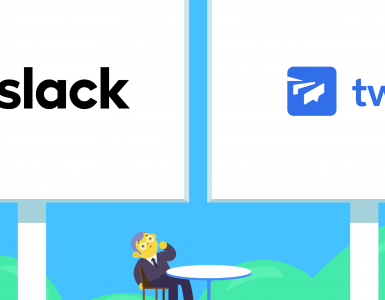With the onset of the pandemic and the shift in workplace behaviors, there was a sudden need to facilitate collaboration and digitization to enhance productivity and maintain consistency between team members across different locations and time zones.
Satya Nadella and Bill Gates wanted to bid $8 billion USD to acquire Slack, the team chat SaaS company. Their meeting took an extraordinary turn, and instead of buying Slack, they decided to create their own app.
Microsoft Teams was officially launched in November of 2016. This online collaboration platform consolidates Microsoft Office 365 with team chat and multiple organizational tools. On the face of it, Teams and Slack are quite similar, leading many to ask, Is Slack like Teams? However, they differ significantly in terms of functionality, especially as remote working and hybrid working models have become the norm.
The debate of Slack versus Teams often arises when businesses look for the perfect collaboration tool.
As we are building Chanty, we have actively used both platforms to understand their pros and cons. Here’s our review, based on our team’s first-hand experience.
If neither Slack nor Teams convince you, you can always try Chanty, a team chat and collaboration app that offers an unlimited message history even in the free plan.
These platforms are absolute leaders in this space, and while both offer chat, notifications, and multiple other productivity integrations, there are a few clear differences.
Here we’ll compare features, pricing, and much more to help you decide which tool is best for your business.
Slack vs Microsoft Teams: fast facts
If you are looking for a brief overview, here are all the facts that you need to be aware of, to make that decision.
The biggest difference initially was that Teams didn’t have a free plan. However, in July 2018, Microsoft introduced a robust free version that includes chat, video conferencing, and limited file storage, making it a strong competitor to Slack.
Slack is comparatively easier to sign up for and use, whereas Microsoft Teams is designed for larger enterprises and organizations. Hence, the setup is more complex and secure. It also offers additional integrations with Office 365 applications. However, Slack allows a whopping 2000+ integrations, including essential apps, brilliant bots, and the best CRM software.
If you’re wondering, is Slack like Teams? The answer depends on what you value more: ease of use or enterprise-level functionality. Both tools excel in collaboration but cater to slightly different audiences.
We also have a full, detailed review of Slack on our blog as well.
Slack vs Teams comparison
| Slack | Microsoft Teams | |
| Pricing model | FreemiumPro plan offers $7.25 per person/month, when billed yearly and $8.75 per person/month when billed monthly Business+ plan offers $12.50 per person/month, when billed yearly and $15 per person/month when billed monthly Enterprise Grid plan offers a customizable plan upon contact to the sales team | FreemiumMicrosoft Teams Essentials offers $4.00 per person/month paid annuallyMicrosoft 365 Business Basic offers $6.00 per person/month paid annuallyMicrosoft 365 Business Standard offers $12.50 per person/month paid annuallyMicrosoft 365 Business Premium offers $22.00 user/month paid annually |
| Message history limit | 90-day message and data history in the free planUnlimited message and data history in Pro, Business+ and Enterprise Grid plans | Unlimited in all plans |
| Audio/video calls | Unlimited 1:1 voice and video calls in Free planConference calls for up to 50 participants in Paid plans | Voice or video calls with up to 250 people in a meeting. |
| Integrations | 10 integrations limit in free plan2400+ integrations in paid plans | Over 250 integrated apps and services for Business Basic and Business Standard plans |
| File storage limit | 5GB file storage for a team in the free plan (only for 90-days)10GB per person in the Pro plan20GB per person in the Business+ plan | 5GB across all teams in the free plan2GB of cloud storage per person on Microsoft Teams Essentials plan1 TB cloud storage per person in Business Basic and Business Standard plan |
| Screen sharing | Unavailable in Free versionAvailable in Pro and Business+ versions | Available in all plans |
| Interface color options | Custom sidebar themes | 3 themes (light, dark, high contrast) |
| Conversation threads | Available on all plans | Available on all plans |
Read More on Slack Pricing.
Slack vs Teams: pricing
Both platforms have free plans. However, it’s better to opt for one of the paid plans to get the most out of Microsoft Teams and Slack. As of 2024, the most affordable Office 365 plan that includes Teams is called Microsoft 365 Business Basic. It costs $6 per user per month, billed annually, and provides access to Teams along with other essential Office 365 apps.
Slack’s lowest-priced plan, i.e., the Pro plan, costs $7.25 per user per month, which is also billed annually. If you consider Microsoft Teams, you will spend $6, which will also give you access to Office 365, which will make the value proposition much more attractive.
For the upgrade of both plans, Slack or Microsoft Teams, they both cost the same $12.50 per user per month, but Teams comes with Office 365 included. However, with Microsoft a third plan has been introduced under the name of Microsoft 365 Business Basic where you can upgrade with only $6 per user per month (billed annually). This makes Microsoft Teams a better option price wice.
When comparing Slack versus Teams, it’s clear that pricing plays a significant role in decision-making. While Slack emphasizes simplicity and flexibility, Microsoft Teams offers better value for businesses already using Office 365.
Slack offers an enterprise plan too, which offers 1 TB of storage for each user, but for the exact pricing you’ll need to contact Slack’s support.
If the price is a concern, you may want to consider Chanty as an alternative. It is priced at $3 per user per month, with advanced features like unlimited message history as well as both audio and video calls. This makes it a far more affordable option compared to Slack or Microsoft Teams.
Slack vs Teams: getting started
Getting started with Microsoft Teams requires lots of time and patience. In our experience, the setup itself is quite intimidating. We started out at the very bottom, with no Office 365 subscription.
We began with the Tools page on the Microsoft website, where there is a sign-up form to download the app. Whether you sign up for a trial or a paid plan, you’re still asked for a lot of personal information, including a credit card, phone number, and business email; personal emails don’t work!
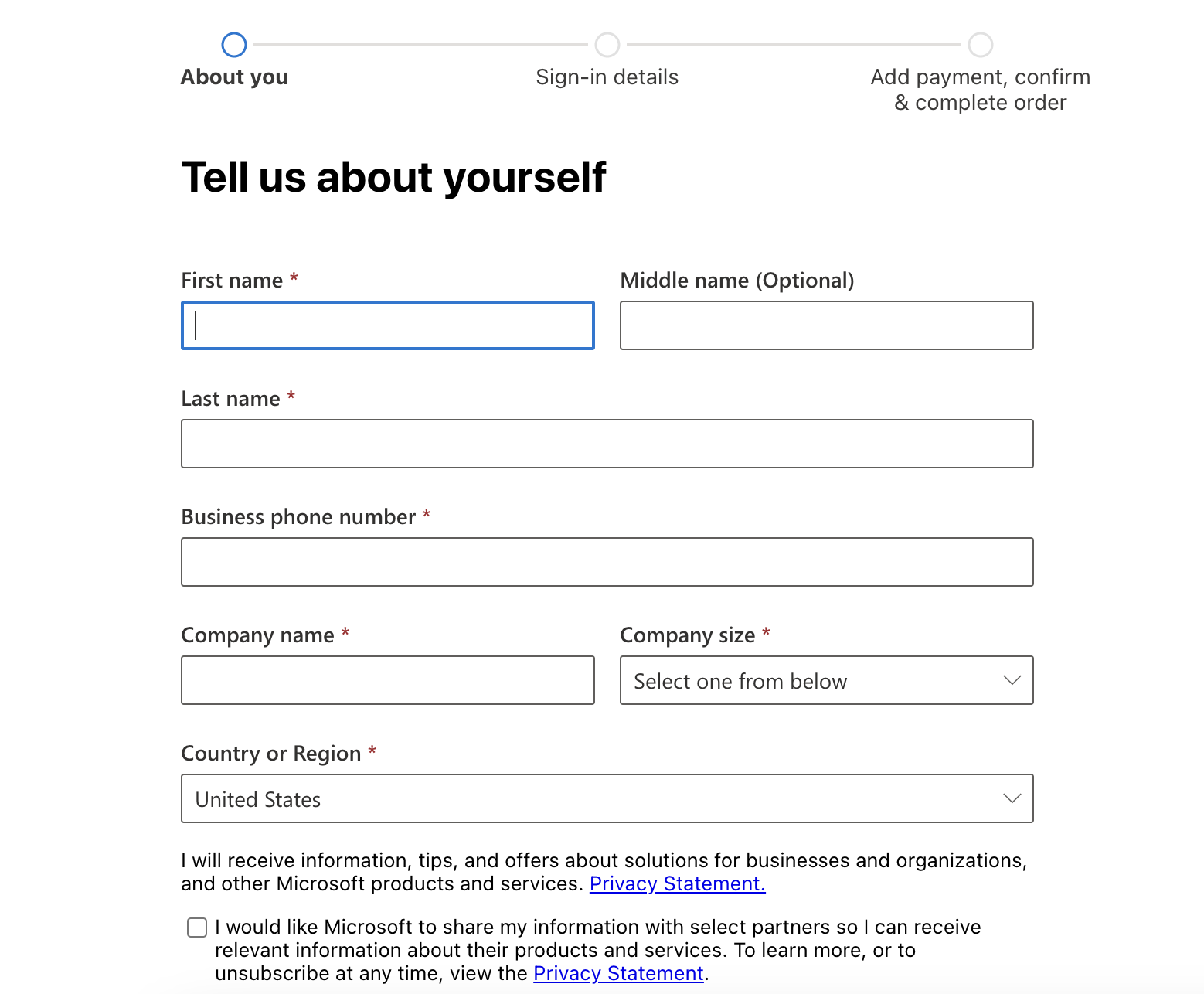
Office 365 Business Standard registration
Once you have completed registration for the free trial or paid plan, you will be given access to the Team Workspace where you can invite your teammates and start collaborating.
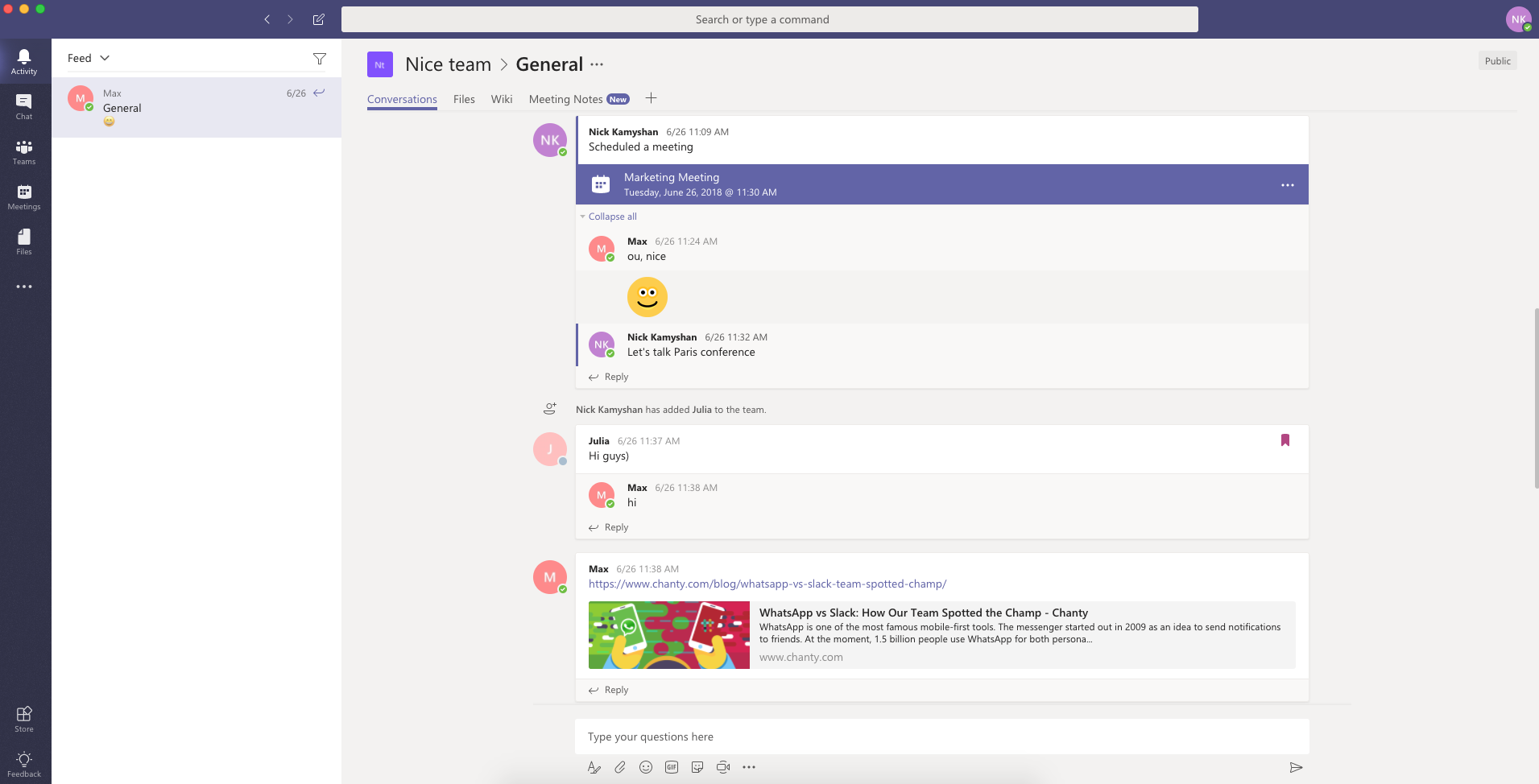
Microsoft Teams workspace
On the other hand, getting started with Slack is much faster. The registration requires no personal details, and you are not asked to share any payment details unless you are signing up for the paid plan. The sign up process is easy and includes 7–8 steps.
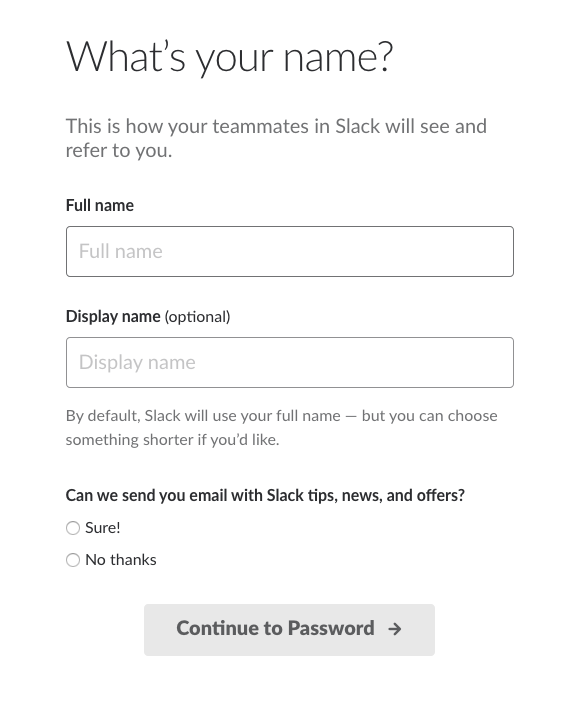
A registration modal box in Slack
In total, registering and getting started with Slack took nearly 7 minutes, in comparison to the hour spent on Microsoft Teams.
Slack vs Teams: inviting users
Inviting people to Slack is pretty straightforward. Once you sign up, the platform will prompt you to invite people to your workspace. Alternatively, you can use the ‘Invite people’ option to send them an invitation.
Whereas, adding new users and guests to the Team platform is slightly more complicated. They have to be added to the Office 365 admin portal from the office page first.
Once they are added to the Admin Portal, they will receive an email with an invitation. On accepting the invitation, they log on and create a password. Once the user account is created, they can then be added to the Microsoft Teams application.
Our colleagues who tried Microsoft Teams mentioned that it took really long to register on the platform.
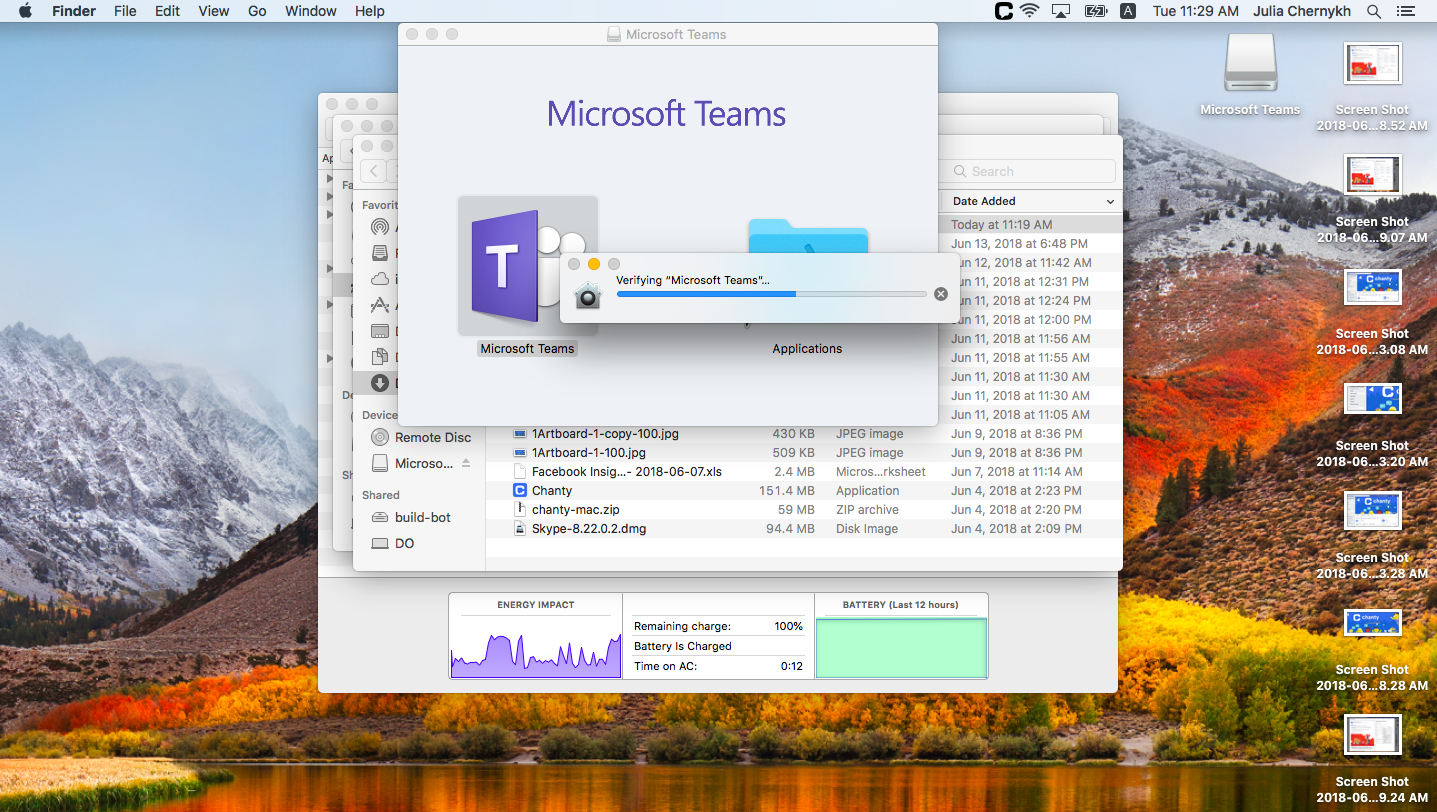
My colleague sent me a screenshot arguing that getting MT started takes too much time
Getting started by inviting new users and guests doesn’t have to be so time-consuming. This job is better off being designated to the IT administrator as opposed to the team leader or executive doing it.
On that note, a tool like Chanty could be a smart choice; it’s extremely easy to register, set up, and use.
Slack vs Teams: layout and design
The layout, design, and feel of the two platforms are fairly similar. Both have a vertical panel for your contacts and settings, along with a larger panel for the conversations and threads.
Slack’s layout vs. Microsoft Teams’ layout:

On the extreme left, Teams has an extra panel with other features like activity, chat, meetings, files, etc. Additionally, the Teams search bar offers many different functionalities than Slack.
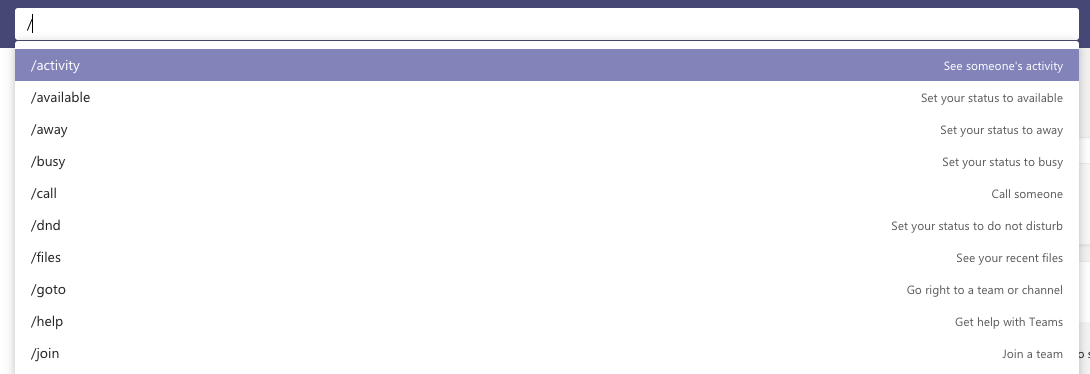
Microsoft Teams search box
Slack has more options when it comes to personalizing the design of the app, allowing you to change the theme and color of the interface according to your preferences.
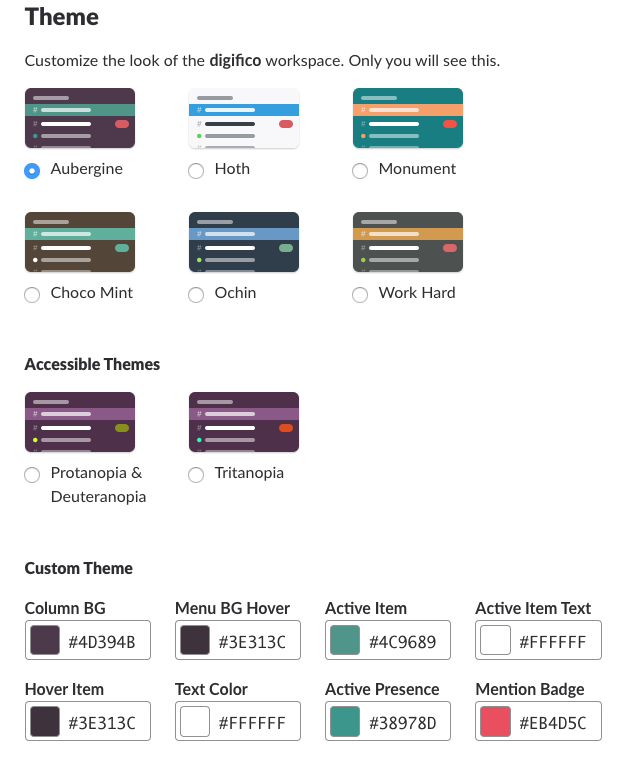
Options for customizing your workplace in Slack
Microsoft Teams has only three themes that you can use to customize the interface.

Options for customizing your workplace in MT
Slack vs Teams: messaging
Both Slack and Teams offer 1:1 messaging, which is a fairly basic functionality. Moving on to the interesting features, both of these tools offer group chat with threads. It allows the users to edit, delete, pin, and react to the messages, as well as mention another user with an “@.” Users can very conveniently start a new thread, share files, and integrate other apps to help increase productivity.
The biggest difference between these platforms is that Microsoft Teams has advanced options to format any text sent in messages, which allows the users to create bullet lists, change colors, and also change fonts.
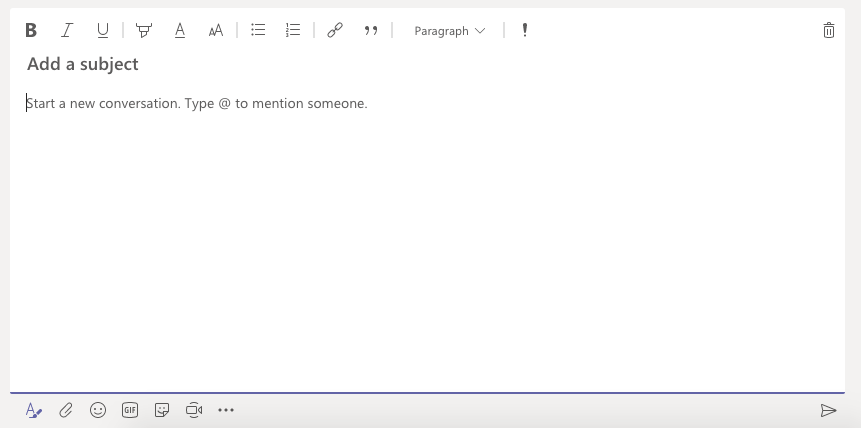
Formatting options in MT
One of the many fun features of Microsoft Teams is that it allows users to send gifs. Finding the right emoji is also incredibly easy because all you have to do is type the right word into the search bar and you’ll get a slew of matching results.
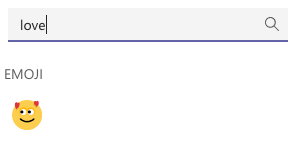
Emoji search by name in MT
Alternatively, Slack also allows you to react to messages in threads with different emojis and not just a simple “like.” It also allows users to mark messages as reminders and set alarms for them. Below is a simple comparison of the messaging capabilities of both tools.
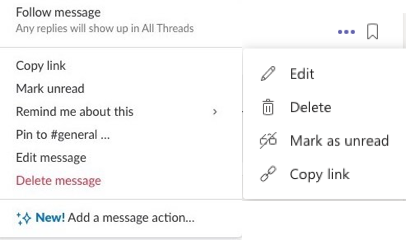
Slack Microsoft Teams
When it comes to notifications, both tools have advanced systems that can be personalized according to the user’s preferences. But neither app has a central hub for notifications, similar to what Stride used to have.
Slack vs Teams: threads
If you prefer regularity in the conversation, you might really like threads. They allow us to maintain more structured and organized communication.
To create a thread in Microsoft Teams, all you have to do is select the reply option on a message. There is an “All Threads” tab, where you can view all your opened threads. Additionally, you can also do that by pinning a message or marking it with a “star.”
In Teams, the only limitations are that you can only use threads in channels and not in private conversations, and they cannot be turned off.
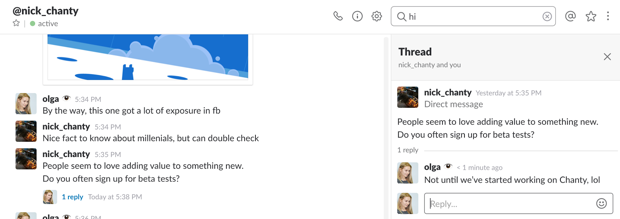
Using Threads in Slack
Slack vs Microsoft Teams: file sharing and collaboration
Slack’s storage limit for uploading is 1 GB, while Teams is capped at 15 GB.
We were very interested in understanding how seamless collaboration could be on these platforms. We decided to try uploading an 800 MB video file to Microsoft Teams. It was pleasantly surprising to see that the file opened and played within seconds in Microsoft Teams—very impressive.
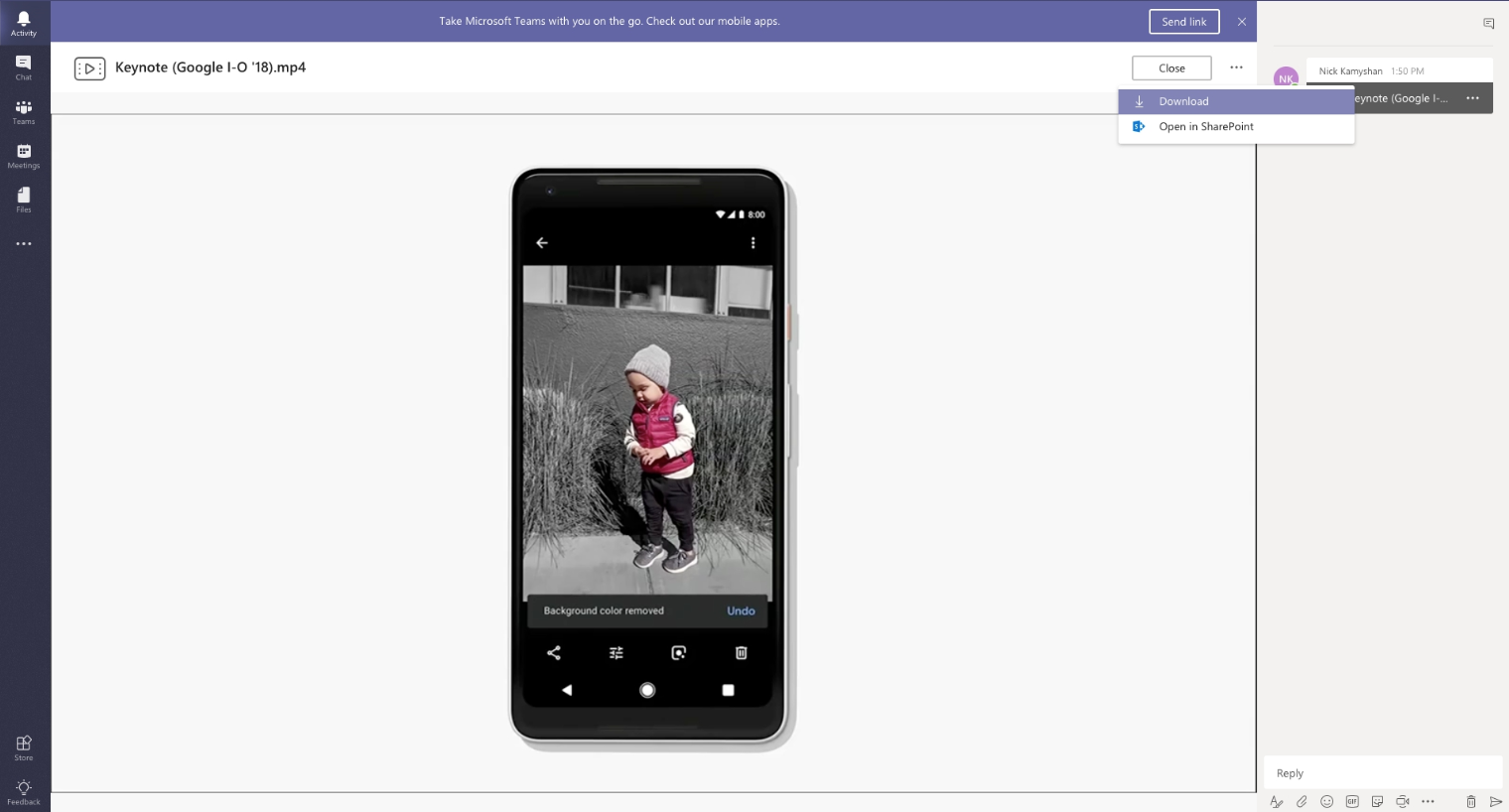
Watching a video within MT workspace without downloading it
On the contrary, you would have to download the video file to be able to play it on Slack.
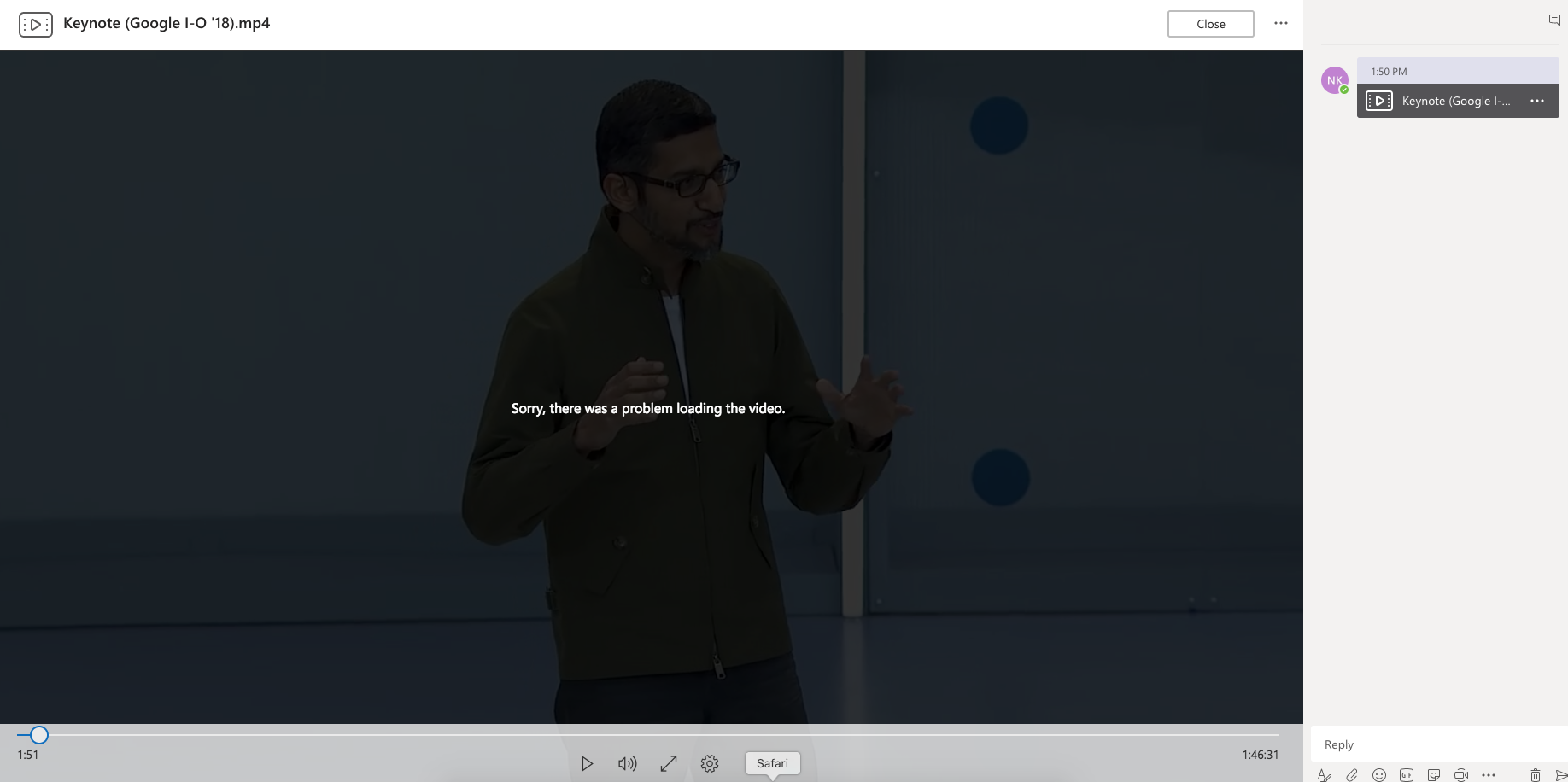
Experiencing some troubles with uploaded video
Our idea of healthy collaboration is being able to watch the video together with the team and speak with them simultaneously; unfortunately, this is not possible in Slack. The fact that Microsoft Teams supports it, definitely makes it a stronger competitor.
It allows you not only to watch videos but also to comment on them at the same time as watching them. You can also collaborate on MS Office and OneDrive documents with Teams, without leaving the App.
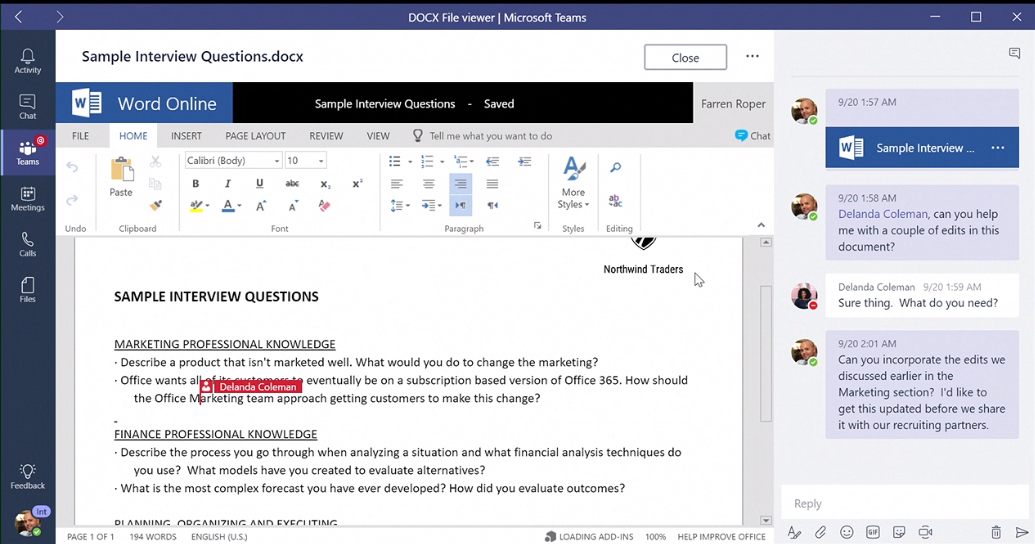
In terms of storage limits, Slack provides 5 GB in the free plan and up to 20 GB in the paid plans, per user whereas Microsoft Teams provides 1TB per organization.
Slack vs Teams: video calls
Here are some screenshots of video calls from Microsoft Teams. We were pleased with the video calls on Teams because the audio and video quality were excellent.
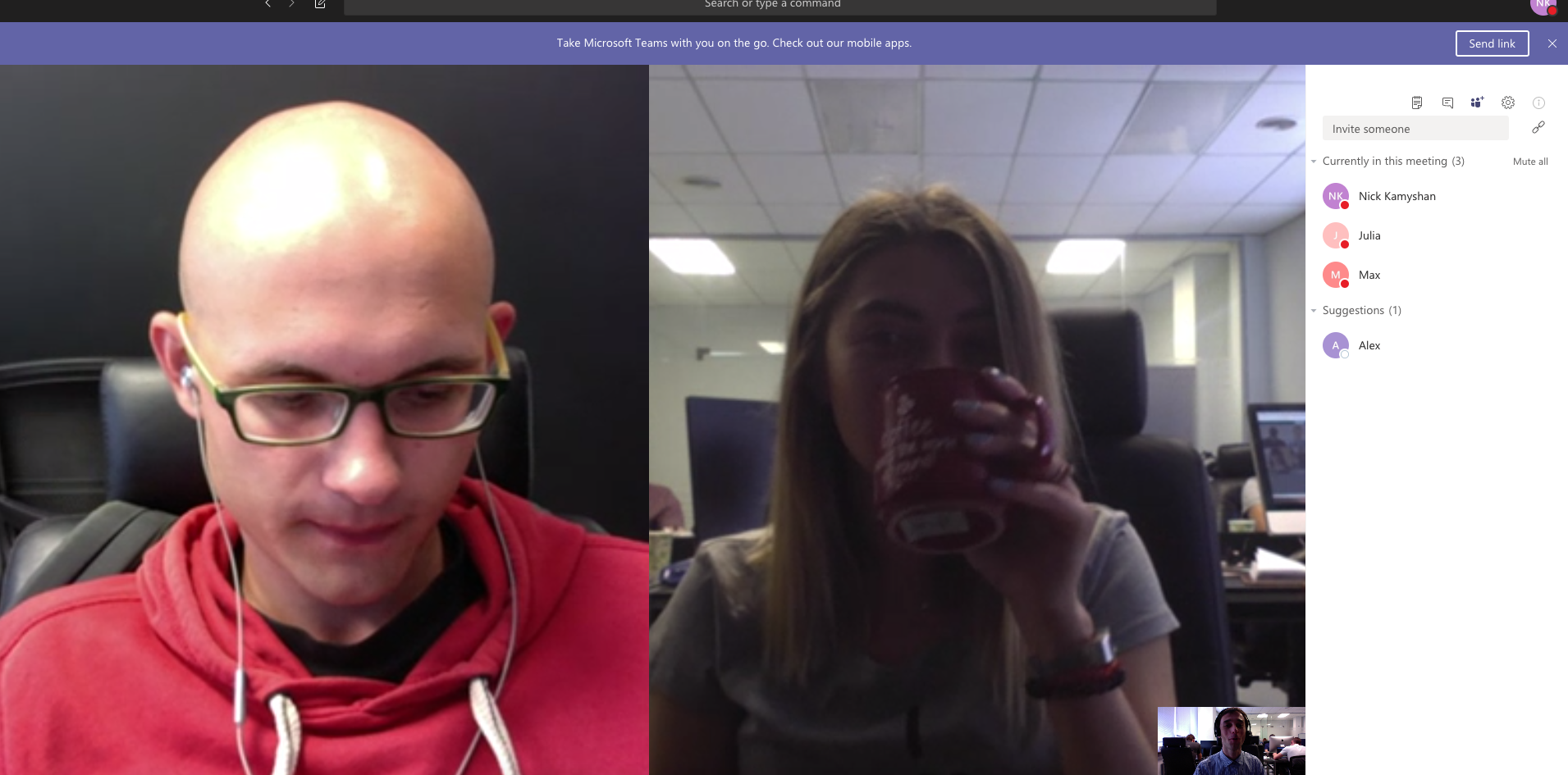
Chanty team is exploring video calls in Microsoft Teams
If we wanted to, we could switch from instant messaging to video or audio calling by pushing a single button.
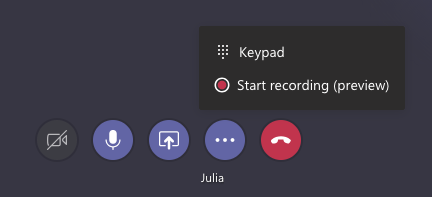
Video calls features in MT
Additionally, we tried to record video calls. Once you hit the record button it instantly starts recording, and a few minutes after the call ends the video shows up in the chat window. It’s actually pretty impressive.
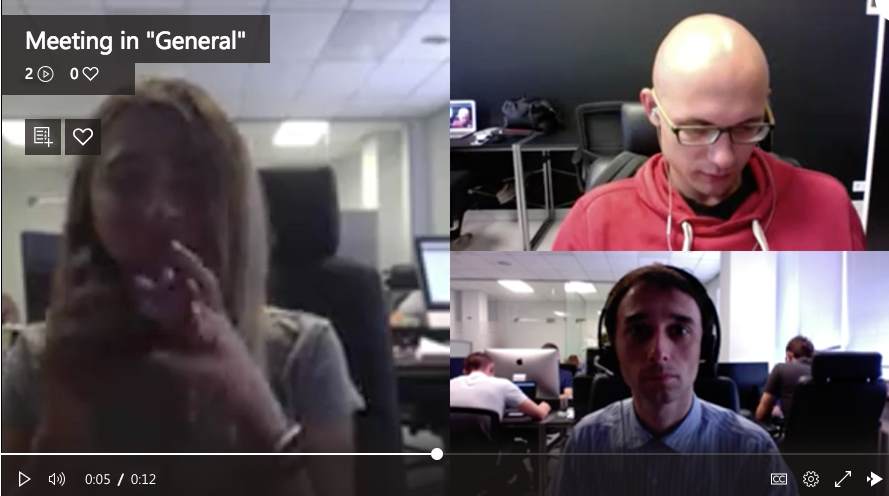
With Slack’s free plan you can only talk to one person at a time. If you have opted for the paid plan, you can add up to 15 users.
Microsoft allows adding 300 participants in group video calls with their paid plans.
Slack vs Teams: integrations
Teams integrates seamlessly with Office 365 being a Microsoft product. If you use SharePoint, OneNote, PowerBI, or Planner, it will be very convenient for you with Teams. It also supports many third party integrations such as Trello. Teams currently supports 250+ external integrations.
That sounds amazing, until we realise that Slack supports 2400+ integrations. Companies are trying to constantly come up with Slack integrations and the number of supported apps are increasing daily.
Slack vs Teams: task management
Neither of the two apps have a built-in task management feature.
Slack has an “Actions” feature which can be used to create, allocate and work on tasks without getting out of the App. However, this functionality can only be used through integrations. Similarly, Teams has a “Planner” option that can be used to manage and plan your tasks.
If you need a team communication and collaboration app that supports task management functionalities, give Chanty a try. The built in task management feature can easily help turn messages into tasks. It also has a Kanban board that helps to filter tasks by status, people, and deadlines.
If you’d like to learn more about Chanty and its functionalities, sign up for a demo today!
Slack vs Teams: search
The “search” option in Slack is very convenient. It can easily help sort through messages, contacts and files. Slack also has a capability to search for content within other documents. This allows you to find words and phrases within Google Docs and Dropbox files.
We searched for the phrase “celebrating workplace diversity” which was in one of the PDF’s. – Of course, Slack search was able to find it.

A snippet of the book Slack found it!
We tried the same with Microsoft Teams, it worked just as nicely (screenshot below).

Microsoft Teams searches the content within files
Slack vs Teams: help and support
Both Microsoft Teams and Slack claim to provide 24 x 7 support.
We made up a scenario – If you wanted to delete a channel in Slack or Teams, what would you do? You would first look for help.
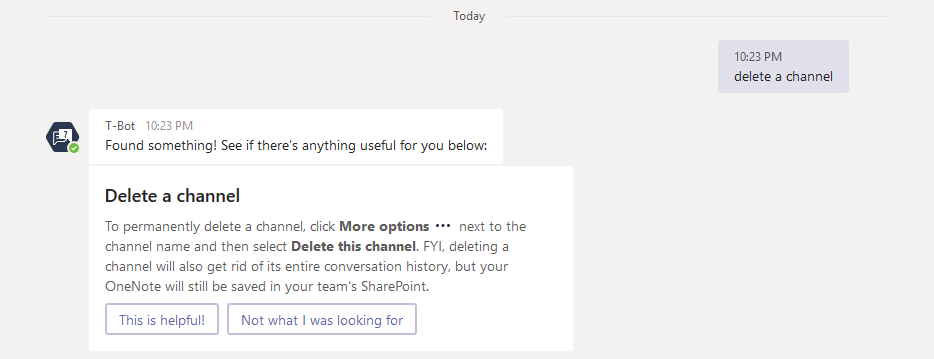
T-Bot is answering questions in MT
T-Bot provides constant support for Teams.
You log into the app called T-Bot where you will find a chats tab. You simply type “Delete a channel” and get very useful instructions.

Sections within a bot to browse “Help” content in MT
On the other hand, it is easier to get help in Slack by directly going to their Help Centre. You just type the keyword “Delete” and the answer is right in front of you.
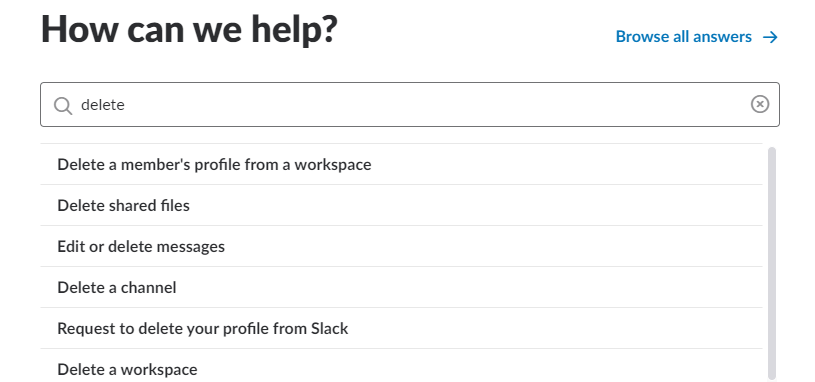
Help Centre in Slack
However, if you want an immediate answer, searching the problem on google would be an even better idea.
Wrapping up
Price: Both Teams and Slack offer free plans. However, when it comes to paid plans, Microsoft Teams’ pricing remains competitive, with its cheapest plan typically lower than Slack’s lowest tier. So Teams wins this round.
Getting started: Slack continues to be recognized for its user-friendly onboarding process, making it convenient for new users to get up and running quickly. In contrast, Microsoft Teams may require more time to set up and manage, especially for larger organizations, due to its integration with a broader suite of tools.
Layout and design: Microsoft Teams has multiple options and tabs. On the other hand, Slack continues to improve its interface, focusing on user experience and functionality. Slack also offers more personalization options, allowing users to customize their workspace to a greater extent than in Teams.
Messaging: Slack and Teams have multiple ways to send and receive messages, including threads. Microsoft Teams allows the users to format the text while Slack comes with the functionality to set reminders on individual messages.
File sharing and collaboration: Teams allows you to share Office 365 files and work on them together on the workspace. On the other hand, Slack does not come with that option, so in order to edit documents, you have to download them and share them again.
Video calls: Both these platforms allow video calls and the functionality works very well. Microsoft Teams allows users to record video calls, making it a valuable tool for reviewing discussions later. Teams can accommodate up to 300 participants on paid plans, compared to Slack’s limit of 15 users on a single video call.
Integrations: Teams comes bundled with Office 365 apps and 250+ third-party applications. Slack is a clear winner here with 2400+ application integrations.
Task management: Both platforms need external integrations to support task management. In Slack you can assign and manage them using “Actions” and in Teams the same can be done with the “Planner” tool.
Search: Teams and Slack allow users to search through their chat history, contacts, and shared documents efficiently. Recent updates have improved search capabilities, making it easier for users to find specific content in their conversations.
Help and support: While both platforms offer extensive help centers, community forums, and chatbot assistance, Teams provides direct 24/7 phone and web support for paid users, something Slack lacks. Slack relies heavily on its help articles and community, with live support available only on higher-tier plans.
Bottom line: In terms of Slack versus Teams, both are really good, but they just satisfy different needs. Is Slack like Teams? Not quite. Slack shines in integration and being able to be tailored toward more flexible and creative workflows, while Teams shines in situations where larger enterprises have a more formal structure, especially those already on Office 365.
Teams could be a better option if you have a dedicated IT team that can install the app for all team members.
Teams also help to reduce language barriers, considering it comes with a real-time translation functionality (supported languages below), while Slack is only available in English.
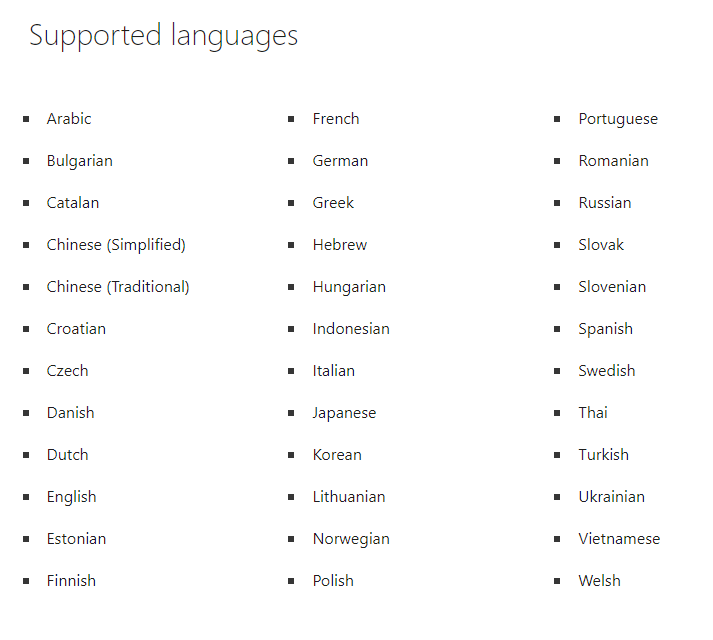
Additionally, if you’re looking for a team communication app that is easy to set up, you should try Chanty! It comes equipped with audio and video calls, screen sharing, and a built-in task management tool. It’s extremely easy to set up and use. If you’re interested in Chanty, you can sign up today or book a free demo!





